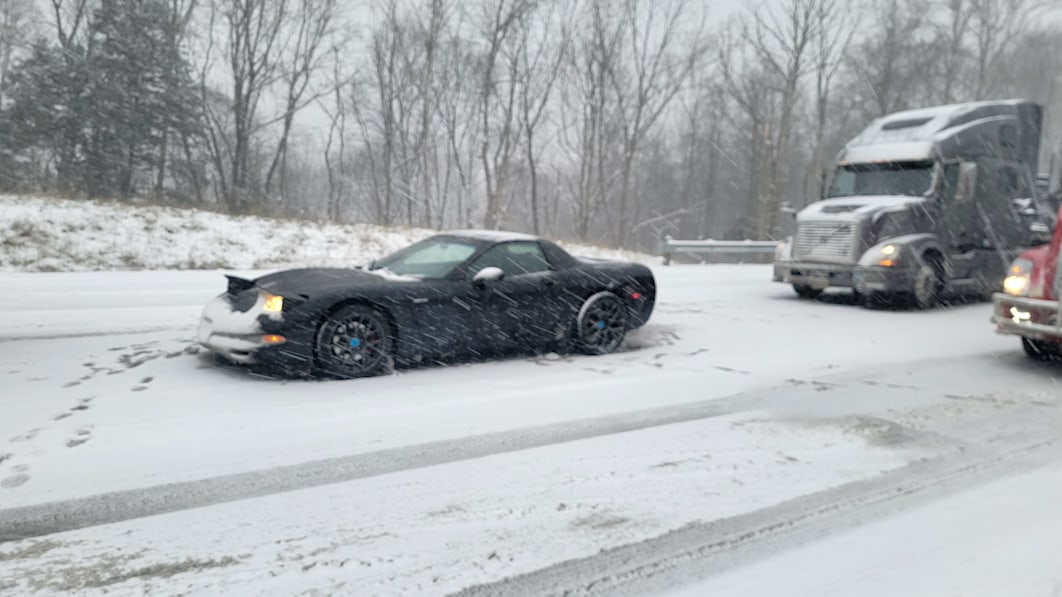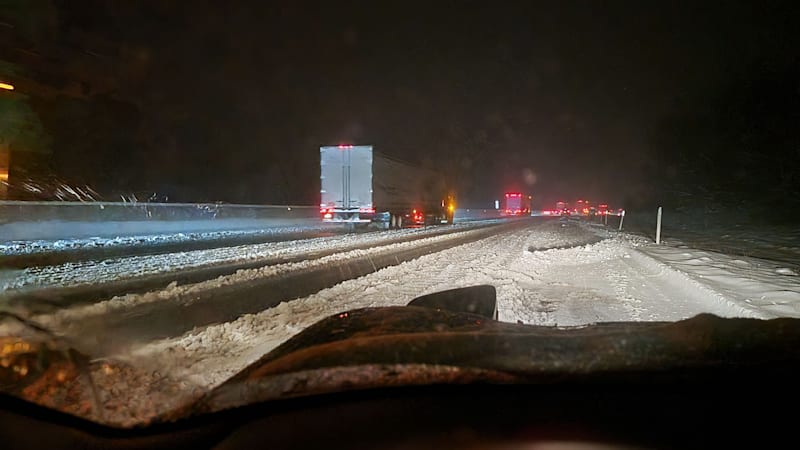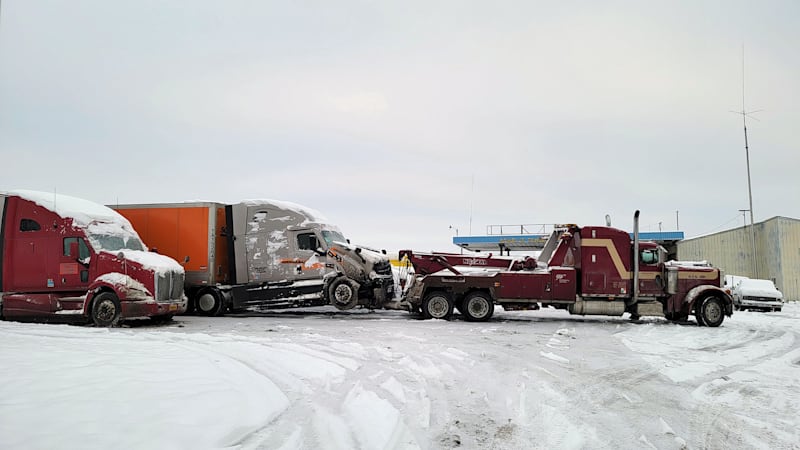How I survived a blizzard in a Corvette Z06 on summer tires

Yes, that was me, two weeks ago in the snowbound mess on I-75 in Kentucky.
Let me explain.
One of the most-read pieces on Autoblog last year involved taking a Corvette places it probably shouldn’t have been after a blizzard in the shadow of Mt. St. Helens. As we posited in the headline for the Chevrolet Corvette Convertible Road Test Review, “Mountain road after a blizzard. What could go wrong?” I did not have that piece in mind when I recently ended up stuck on the highway. But if I had had, my review would be titled, “2001 Chevrolet Corvette Z06 Road Test Review | Frozen highway during a snowstorm. Everything went wrong (until it went right).”
It started just before New Year’s, when I decided to make a quick trip to Florida to visit a friend from my home near Cincinnati. The weather the day I left wasn’t merely unseasonable, it was an absurd 71 degrees. Looking at the 10-day report, forecasters didn’t predict anything even approaching the unsavory for at least a few days after I’d be back. So instead of grabbing the keys to the Buick or the Land Cruiser, I grabbed the keys to the Corvette.
This was going to be a breeze.
And it was, until I got a flat tire on New Year’s Day, which led to a series of unfortunate delays and poor decisions. No one will be surprised to find out that tire shops don’t keep a 290/35-section Michelin Pilot Sport 4S in stock at the end of December. So instead of departing on Sunday, January 2 and being back home the following day, when temps had stabilized at a more reasonable 33 degrees with no precipitation, I didn’t leave until Tuesday evening.
I drove overnight to just past Atlanta and got a hotel room. Still fatigued that evening, I decided to stay overnight and leave after a good night’s sleep. This was the first of a series of missed opportunities to avoid what would happen the following day on the return trip from Florida.
On Thursday, everything was fine until after Knoxville, Tennessee, about 200 miles from home. Then the snow began, light, but sticking. By the time I crossed the Kentucky border, the landscape was white. Traffic remained fluid, moving about 45 to 50 mph. The roads were a touch slushy, but nothing problematic.
Getting into Kentucky hill country alongside the Daniel Boone National Forest past Corbin, patches of ice appeared. I saw my first car in the median. On the following curve, the back of the Corvette stepped out twice, two gentle slides that the electro-nannies quickly corrected. Then I saw the first overturned truck.
I did not pull over. I kept going with the even slower flow of traffic. As long as traffic moved, I liked my chances.
I made it another 30 miles. Then, on an incline about two miles past the Mr. Vernon exit, traffic stopped. My chances cratered to zero.
At 2:24 p.m. on Thursday, I texted a friend to say I’d be home late. People who could turn their cars around and drive on the right shoulder against traffic back to the Mt. Vernon exit were doing so. With my car on brand-new summer tires, I didn’t want to risk going downhill and sliding into any of the hundreds of cars between where I was and the exit ramp.
Southbound 75 was clear. I got out to see if there was a break in the low concrete wall separating northbound from southbound traffic that I might squeeze through. There was none.
The trucker next to me honked as I walked back to my car. Considering the situation, I was prepared for any question. His name was Mike, and he was irrationally awesome. Instead of asking me a question, he gave me an update on the situation: A huge pileup ahead, we were going to be there for at least two hours. That estimate sounded optimistic. We chatted about trucking for a bit. Then he gave me two bottles of water and a couple of granola bars, and I returned to my car.
At least I was wearing warm clothes, and I had enough warm-weather clothing in my duffel to layer up and forestall freezing to death. At 2:52 I was down to just under half a tank of gas, so I began rationing, running the car 10 minutes every hour.
An hour later, Mike told me the estimate for clearing the road ahead was another two hours.
An hour went by. Two plows had passed, clearing the left shoulder. Cars and trucks that could follow them did so, until the plows got stuck about a quarter of a mile ahead of where I was. Now there were four lanes of stopped traffic instead of three.
About 40 minutes later, Mike came over and told me it looked like we might be moving soon. The problem now was that it had been snowing an inch an hour and the mercury was dropping, so the snow under my tires had turned to ice. Mike said he had a snow shovel, and kindly let me borrow it to clear a path from where my car sat to the cleared lane. I chopped up the ice and snow and carried it out of the way until I was able to slither the Corvette into an open space in the cleared lane.

The last light of a gray sky had faded by the time traffic got moving again, doing maybe 15 mph. The next exit with safe harbor was Berea, about 14 miles ahead. I was back to my mantra, having moved to the right lane: If traffic keeps moving, I should get there.
But the plows hadn’t done much beyond where they got stuck before, so the roads were still beset by ice that had accumulated during the wait. I made it down the first hill after where I’d been parked, but when traffic stopped again while going up the following incline, the rear tires wouldn’t push the car another inch forward. I reversed onto the shoulder, parked 127 miles from home, sandwiched between the right lane of traffic passing barely 3 feet from my driver’s door, and the snowdrift beside the passenger door. The chances of getting brained were high. Perhaps 70 feet behind me, an 18-wheeler was stuck in the middle lane. Figuring the angles, I realized my car was in the perfect position to be clobbered by another vehicle sent spinning out of control after trying to avoid that truck. The chances of getting brained went way up.
There wasn’t much I could do. The Corvette could only go backward, down the hill. Doing so meant risking sliding off the shoulder, or into traffic. No, thank you.
I was down to three-eighths of a tank. I checked the weather. More freezing temps the next day, but 47 degrees on Saturday. I planned for the worst, being stuck in the car until Saturday when the snow would start to melt. I grabbed my duffel and layered up. I still had the water and granola bars Mike had given me. Assuming I made it through the night, I’d walk the four miles back to Mt. Vernon to grab some gas cans and food to survive until Saturday.
I got in the passenger’s seat, put on the seatbelt, and closed my eyes.

Two hours went by. The occasional 18-wheeler got stuck climbing the grade, but wiggled out and onward.
At 9:22 p.m., stupendously bright lights shone through my windshield. I opened my eyes and made out the back of a truck tractor. I thought a bobtail had got stuck and the driver had turned on his exterior lights. But no, it was a wrecker parked in the right lane about 30 feet ahead of me, come to move the big rig out of the middle lane and onto the shoulder. At some point before I woke up, the wrecker driver had run his tow line next to my car. When I realized that, I got out; I didn’t want to be in the middle of the action if things went wrong.
I don’t think the wrecker driver, whose name was Aaron, with ThroughTruck towing, had seen me in my car. The left side of the Corvette was covered with falling snow and frozen slush thrown up by passing cars and trucks. When Aaron saw me get out, he shouted, “Get in my truck and get warm.” Invitation accepted.
After Aaron finished getting the rig onto the shoulder, he said he’d give me a ride to Berea with the previously stuck truck driver. I went back to my car to grab a small bag, then Aaron showed up to say his brother Caleb wasn’t far away with a flatbed, and if I wanted, Caleb could get me and my car to Berea or wherever I could find a hotel.
Yes. I wanted.
I could write another 1,500 words about how happy I was not to be faced with 36 hours of living in my car doing some terrible, low-budget reboot of Into the Wild. To keep this brief, I will describe myself simply as: Over-f***ing-joyed.
Aaron wouldn’t let me wait for his brother by myself — he stood with me in the cold on the side of the road until Caleb showed. Then Aaron said goodbye, taking his charge with him and carrying on to the next wreck not much further up the road.
Caleb told me to get in his truck and get warm while he loaded up my car, continuing the familial onslaught of embarrassingly hospitable hospitality. In the warmth of the cab, I looked for a hotel. Of course, everything from Kentucky to Canada was booked, and police had closed the highway not far after Berea. But there was a 24-hour truck stop in Berea, which meant 24-hour food and restrooms, and I’d be happy with it.
As Caleb and I talked classic cars, like the Dodge Charger he’s restoring, I saw carnage at regular intervals in the 14 miles to Berea. Plenty of people had been far less fortunate than I’d been, which, frankly, wasn’t hard, seeing as I had been insanely fortunate.

Caleb dropped me and the Corvette off, equally gently, beside the 76 Fuel Center. When I mentioned buying gas at the BP station a couple of blocks away, Caleb had another one of his drivers, Miguel, take me there and let me borrow the two-gallon can in the tow truck. I went inside the BP to buy a second gas can, since I needed enough to keep the car running intermittently for another 12 hours when I could get a hotel room. The attendant asked me what I wanted the gas can for. I explained, and he told me don’t bother, then walked me outside to a spot behind the station’s dumpster where he kept empty DEF cans for people like me. “Those gas cans are expensive,” he said. “This should do.” I tipped him half the price of the gas can I was going to buy.
“You don’t need to do that,” he said. “Oh yes I do.”
Set up with a parking spot, gas, a gas can, sustenance and safety, I finally asked Caleb how much the tow was going to cost me. When he paused half a second, I thought, “Here we go …” It wasn’t like I was going to complain, though; a maxed-out credit card beats 36 hours at 24 degrees and a high degree of death.
“Seventy-five dollars,” Caleb said.
I couldn’t believe my ears.
I asked, “Is that the Corvette price?” as if he were trying to gouge me. Then I laughed and handed over my card, wondering what the adjectival phrase above “insanely fortunate” is.
I tried to tip Caleb and Miguel, too, but neither one would take the money nor let me buy them food at the restaurant. I say once more, embarrassingly hospitable hospitality.
I slept in my car that night, the Econolodge across the street the next night, and got home two days later after Saturday’s 47 degrees melted enough of the snow to pick my way back.

I do not recommend trying any of this at home. Nor anywhere else.
Yet winter and its harsh, fast-moving weather aren’t over, so please remember that this can happen to you and prepare accordingly. Sure, you’d likely be in a much better car for the travail, but once everyone is stuck, the field gets pretty even. And don’t think this is just about getting stuck in the wrong car with the wrong tires far from home. During the storms over the holiday weekend, I saw proper winter cars on the shoulders, miles from the nearest exit, with flat winter tires. They were going to be there for a while.
As we detail in our Winter Emergency Kit guide, it’s vital during the winter to leave a small survival kit in the trunk with at least a blanket or sleeping bag, pillow, water, gloves, warm socks, rations that won’t spoil (granola bars, canned tuna with pull tabs, etc.). Bonus points for adding a couple days’ worth of medications for regular drivers or passengers, a small gas can, and a power supply for mobile devices.
Stay with your car with your seat belts on unless the situation demands you get out; inside your car will almost always be warmest and safest. I was prepared to walk the following morning, but I had a straight shot down the highway and was dressed for it. If you do need to take a hike, stay by main roads and walk against traffic – you’ll see what’s coming.
I also recommend giving tow and wrecker drivers plenty of room. It’s dangerous for them at the best of times.
Finally, I recommend leaving your Corvettes and your summer tires at home. Until, you know, summer.







